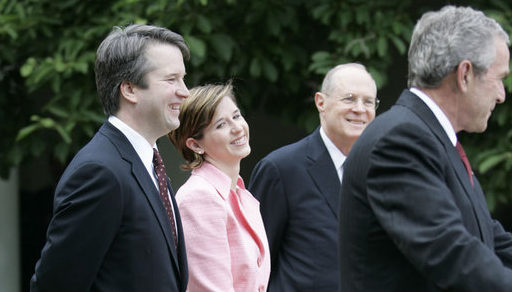Update July 3: For a full list of all of Judge Kavanaugh’s opinions on the D.C. Circuit go here.
The Supreme Court currently has three justices from the D.C. Circuit. After Justice Kennedy’s retirement announcement on Wednesday (June 27), is there room for a fourth?
Judge Kavanaugh is an early frontrunner for the seat. He’s young (53). He’s got the conservative chops. He’s a former Kennedy clerk and the rumored first choice of the soon-to-be retired justice. Not to mention he’s already on President Trump’s shortlist—and some people say at the top of it.
Even his bio page on the D.C. Circuit website suggests that Judge Kavanaugh might like to become Justice Kavanaugh. All the other judges on the court have terse recitations of their schooling and work history, without so much as a photo. Kavanaugh’s, in contrast, is an impeccably curated display, with a beaming headshot atop a long biography that includes not one but two marathon times. (He ran the Boston marathon in an impressive sub-four hours.)
Kavanaugh was nominated to the D.C. Circuit by President George W. Bush in 2003. He didn’t take the bench until three years later because Democrats stalled his nomination and then forced a contentious confirmation fight. Throughout Kavanaugh’s time at the court, he has been a steady and consistent conservative voice. Here are three major Kavanaugh opinions touching on topics that no doubt will re-emerge at 1 First Street.
Abortion. Just last October, Kavanaugh wrote a forceful dissent from an en banc order allowing a 17-year-old undocumented immigrant detained in U.S. custody to get an abortion. He said the majority “badly erred” in what amounted to creating a “new right” for “unlawful immigrant minors in U.S. Government detention to obtain immediate abortion on demand.”
Kavanaugh did more than invoke abstract legal principles. He paired them with an emotional appeal:
The minor is alone and without family or friends. She is in a U.S. Government detention facility in a country that, for her, is foreign. She is 17 years old. She is pregnant and has to make a major life decision. Is it really absurd for the United States to think that the minor should be transferred to her immigration sponsor—ordinarily a family member, relative, or friend—before she makes that decision?
Since Kennedy announced his retirement, abortion-rights supporters have been protesting on the steps of the Supreme Court. A flood of commentators warned “The End of Roe” and “The End of Abortion,” fearing Kavanaugh as the harbinger. Former Supreme Court reporter Mike Sacks, referring to Chief Justice Roberts, had this to say:
But what about Roe, you ask? He won’t possibly vote to outright reverse it, right? He’s just gonna stealth overrule it, approve a bunch of restrictions, right?
No. Roe’s the white whale. He’s gonna harpoon it with his own pen.
— Mike Sacks (@MikeSacksEsq) June 27, 2018
No doubt abortion will continue to be at the forefront of Americans’ minds as the country heads into an era of a true conservative majority on the Supreme Court. Kavanaugh’s role in helping hoist the harpoon is yet to be seen, but you can certainly see where it is aimed.
Environmental law. In 2014, the Supreme Court held that the EPA had misinterpreted a provision of the Clean Air Act when it tried to require stationary sources (think large utility plants and factories) to obtain permits based on the amount of greenhouse gas they emitted. In his majority opinion, Justice Scalia cited a Kavanaugh dissent from a denial of a petition for rehearing en banc in a different environmental case—also involving a challenge to greenhouse gas regulations—in which Kavanaugh lamented such regulations as a symptom of the unbridled expansion of agency power. It was a rare instance of the Supreme Court citing a dissent from a lower court judge, and it shows how in sync Kavanaugh is with a key project of the Supreme Court’s right flank: dismantling the regulatory state, particularly in the area of environmental regulations.
Separation of powers. Two years ago, Kavanaugh penned a panel decision holding that the structure of the Consumer Financial Protection Bureau was unconstitutional. The court sitting en banc overturned that decision earlier this year, but not without a hearty dissent from Kavanaugh. Both his original opinion and his dissent from the en banc decision are vintage Kavanaugh: decrying what he sees as highly concentrated and unaccountable agency power. The bureau’s director “enjoys more unilateral authority than any other officer in any of the three branches of the U.S. Government, other than the President,” Kavanaugh said.
If appointed—and confirmed—to the high court, it would be Kavanaugh’s final post in a long resume of government service. He worked in the Office of the Solicitor General, helped draft Independent Counsel Ken Starr’s report that led to the impeachment of President Clinton, and was staff secretary to President George W. Bush.
During his time working for Bush, Kavanaugh learned and adopted Bush’s idea that Supreme Court nominees should get a vote within 180 days of nomination. In a 2015 lecture at Marquette Law School, Kavanaugh said it is important “to think about rules of the road, no matter which party’s in control, so that when you get in a crisis situation or in a controversy, you don’t have to reinvent the rules each time, which is a real problem.”
Not even a year later, the country found itself in just such a controversy over the Supreme Court nomination of his colleague, D.C. Circuit Chief Judge Merrick Garland. Garland’s nomination was held for 293 days by Senate Majority Leader Mitch McConnell. On Wednesday, right after Kennedy’s announcement, McConnell promised a vote on President Trump’s nominee this fall.
There are 131 days until Election Day—less than half the amount of time that Garland was in limbo. McConnell’s promise could very well get Kavanaugh across the finish line before then. With a sub-four marathon time, Kavanaugh certainly has the stamina to wait it out.
![]()

